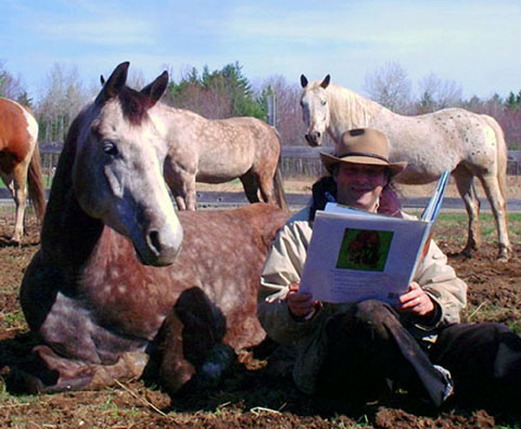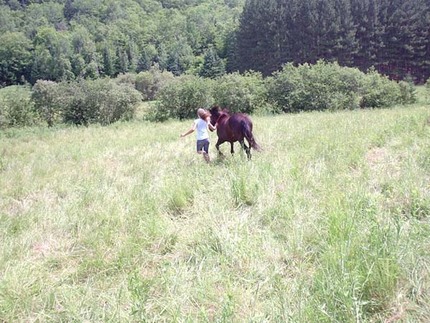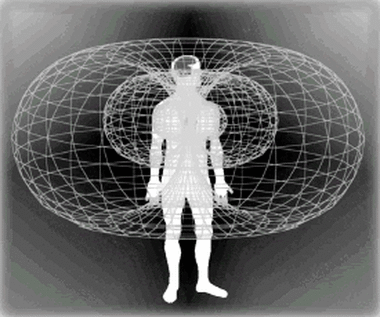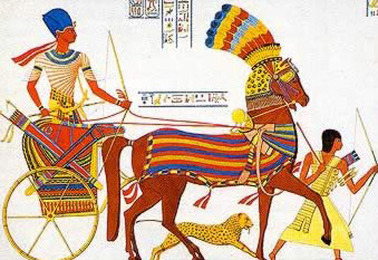The Human Masquerade
by Michael Bevilacqua
November 2011
I was raised in the English language in French-speaking Quebec. My father’s side came from Italy; my mother’s from Ireland. I work in Spanish and dabble in German and Russian. Recently, someone asked me what language I speak best. Thinking for a moment, I sighed to myself as the answer that silently came to my mind was, ‘Horse’.
In the everyday world of smalltalk, my answer to that question is, jokingly, ‘Irish’. No one knows the silent answer within my head or how it hangs heavy on my heart.
Things are so simple when with horses. Honest and straightforward. I can joke with them if I want to, and sometimes do. They showed me that. I can be myself no matter how I feel with no need to explain. No matter what, they can see me, sense me and accept me.
Your body language is important and has to go with how you feel. It is when you are sure of what you are doing and not even thinking about it, that you unknowingly enhance communication through accompanying body movements.
It might be good to have an understanding of how horses interact with each other or their body language but leave that behavior to the horses. You can still fully understand each other in the way that you interact. It is intent that is most important, conveyed and received by the horses. This holds true even in the wild. I have seen photos of a mountain lion lazily grooming herself amid a herd of grazing horses. There is a photo series of three cheetahs that overcome a young impala but since they were not out looking for a meal, they played together and groomed each other. That was the main, touching image portrayed across the internet. However, there appears to be a picture missing. The impala eventually runs away, instinct kicks in all around, and the impala is brought down by the cheetahs. Such is reality in the wild.
We may be predators and certainly have a constant history of absolute attrocity but our saving grace is the compassion and love we also possess. It is important to just be yourself. Let the horses just be themselves. Stop analyzing every situation or movement. If you have that frame of mind of working with an ‘animal’ or using ‘herd behavior’ you will be stuck in that rut. You are going to have trouble in advancing on the relationship and honest comprehension level. Even worse, the horses may be showing something to you, right in front of your eyes, and you will miss it because you are not open to the possibilities. It should be clear that this is not a training method. It is live interaction and on-going learning between you and the horses.
In the everyday world of smalltalk, my answer to that question is, jokingly, ‘Irish’. No one knows the silent answer within my head or how it hangs heavy on my heart.
Things are so simple when with horses. Honest and straightforward. I can joke with them if I want to, and sometimes do. They showed me that. I can be myself no matter how I feel with no need to explain. No matter what, they can see me, sense me and accept me.
Your body language is important and has to go with how you feel. It is when you are sure of what you are doing and not even thinking about it, that you unknowingly enhance communication through accompanying body movements.
It might be good to have an understanding of how horses interact with each other or their body language but leave that behavior to the horses. You can still fully understand each other in the way that you interact. It is intent that is most important, conveyed and received by the horses. This holds true even in the wild. I have seen photos of a mountain lion lazily grooming herself amid a herd of grazing horses. There is a photo series of three cheetahs that overcome a young impala but since they were not out looking for a meal, they played together and groomed each other. That was the main, touching image portrayed across the internet. However, there appears to be a picture missing. The impala eventually runs away, instinct kicks in all around, and the impala is brought down by the cheetahs. Such is reality in the wild.
We may be predators and certainly have a constant history of absolute attrocity but our saving grace is the compassion and love we also possess. It is important to just be yourself. Let the horses just be themselves. Stop analyzing every situation or movement. If you have that frame of mind of working with an ‘animal’ or using ‘herd behavior’ you will be stuck in that rut. You are going to have trouble in advancing on the relationship and honest comprehension level. Even worse, the horses may be showing something to you, right in front of your eyes, and you will miss it because you are not open to the possibilities. It should be clear that this is not a training method. It is live interaction and on-going learning between you and the horses.
You Are Electric
At workshops, in my book, on the DVDs, I mention intuition. That comes from being in the moment. That is why most children will have such magic moments with horses. Horses may do more for a child who is not trying to get anything done than for an educated adult with an agenda. Intuition is not something that is easily worked on or developed. However, it can be allowed to come forth depending on our attitude or state of mind about how we feel in our own life. It is by letting go and living the moment.
Everyone has experienced it at some time even when, on the surface, things seem to be really good or as we want them to be. Yet, there is a funny feeling in our gut, fluttering in the chest or sweaty palms or just some fleeting, hidden thought within us that we choose to ignore.
It was always believed that the heart responded to the information sent to it by the brain. Going back to Hippocrates there were those who believed that the heart served a much greater function. Certainly, that stress and different kinds of emotion affect the rest of the body in various ways. Dr. J. Andrew Armour of the University of Montreal discovered in 1991 that the heart has somewhat of a brain of its own. A network of about forty thousand neurons has been discovered within the heart muscle. It has its own memory and can act independently from the central nervous system. These send signals to the brain and can alter the state of the brain in its wave activity. It does this in four ways: neurologically (transmission of nerve impulses), biochemical (hormones and neurotransmitters), biophysically (through pressure waves) and energetically (through electromagnetic field interactions).
What is also intriguing is the continued work at the Institute of HeartMath located in Boulder Creek, California. The body has its own voltage and sends out info in a radius from the chest toward the skin and further that can be measured (EKG pads that are placed on the torso, for example) The heart can pick up information from the external environment as well and send us signals that can commonly be described as intuition. A situation may appear to our eyes and brain as normal or good, yet, for some reason, there is a funny feeling inside of us that is telling us otherwise.
There were so many times, with horses, that I made a decision or understood something regarding the horse, without being able to explain it. It is important to note that intuition is best described as a sudden, unexplainable awareness rather than a feeling. It is not an emotion that suddenly floods us. If you have a feeling of fear, for example, that is not intuition. Rising emotions in us are linked to our thoughts. If intuition signals danger, that signal, of itself, is just something that suddenly occurs to us. It is then that fear can quickly follow due to our thoughts presenting conjecture based on that danger signal. With intuition, questions come after the answer.
Everyone has experienced it at some time even when, on the surface, things seem to be really good or as we want them to be. Yet, there is a funny feeling in our gut, fluttering in the chest or sweaty palms or just some fleeting, hidden thought within us that we choose to ignore.
It was always believed that the heart responded to the information sent to it by the brain. Going back to Hippocrates there were those who believed that the heart served a much greater function. Certainly, that stress and different kinds of emotion affect the rest of the body in various ways. Dr. J. Andrew Armour of the University of Montreal discovered in 1991 that the heart has somewhat of a brain of its own. A network of about forty thousand neurons has been discovered within the heart muscle. It has its own memory and can act independently from the central nervous system. These send signals to the brain and can alter the state of the brain in its wave activity. It does this in four ways: neurologically (transmission of nerve impulses), biochemical (hormones and neurotransmitters), biophysically (through pressure waves) and energetically (through electromagnetic field interactions).
What is also intriguing is the continued work at the Institute of HeartMath located in Boulder Creek, California. The body has its own voltage and sends out info in a radius from the chest toward the skin and further that can be measured (EKG pads that are placed on the torso, for example) The heart can pick up information from the external environment as well and send us signals that can commonly be described as intuition. A situation may appear to our eyes and brain as normal or good, yet, for some reason, there is a funny feeling inside of us that is telling us otherwise.
There were so many times, with horses, that I made a decision or understood something regarding the horse, without being able to explain it. It is important to note that intuition is best described as a sudden, unexplainable awareness rather than a feeling. It is not an emotion that suddenly floods us. If you have a feeling of fear, for example, that is not intuition. Rising emotions in us are linked to our thoughts. If intuition signals danger, that signal, of itself, is just something that suddenly occurs to us. It is then that fear can quickly follow due to our thoughts presenting conjecture based on that danger signal. With intuition, questions come after the answer.
What is interesting is that the heart and the brain can tune into each other. Furthermore, the heart creates a magnetic field five thousand times greater than that of the brain that radiates out ‘sensing’ the environment and, likewise, can affect the rhythm and signals of someone else. Alternatively, someone can learn to tune in to someone else where the perception and communication can become much clearer. In other words, the heart rate of one person can have an influence on the brainwaves of another by bringing them into sync with each other. This communication is influenced by emotion and is most prominent when a person has feelings of caring, love and appreciation.
Electroencephalograph (EEG) and Electrocardiogram (ECG) will tend to match each other in rhythm patterns either within one person or between two people if they are in close proximity but more so when they touch. This tuning of rhythm between heart and head also results in improved cognitive performance. This exchange of energy into other living tissue also produces a strong theory about the practice of healing.
Intuition is not a training method, either. However, if you can be observant without any kind of preconceived notions about what your horse may or may not be doing, it could permit you to get a clear message. Or easily allow a solution to how to get one across to the horse in a different manner. Focusing on something that may normally come naturally can sometimes get a person quite confused.
Electroencephalograph (EEG) and Electrocardiogram (ECG) will tend to match each other in rhythm patterns either within one person or between two people if they are in close proximity but more so when they touch. This tuning of rhythm between heart and head also results in improved cognitive performance. This exchange of energy into other living tissue also produces a strong theory about the practice of healing.
Intuition is not a training method, either. However, if you can be observant without any kind of preconceived notions about what your horse may or may not be doing, it could permit you to get a clear message. Or easily allow a solution to how to get one across to the horse in a different manner. Focusing on something that may normally come naturally can sometimes get a person quite confused.
Lao-Tzu, in the Tao Te Ching:
The centipede was happy, quite,
Until a toad in fun
Said, “Pray, which leg goes after which?”
This worked his mind to such a pitch,
He lay distracted in a ditch,
Considering how to run.
The centipede was happy, quite,
Until a toad in fun
Said, “Pray, which leg goes after which?”
This worked his mind to such a pitch,
He lay distracted in a ditch,
Considering how to run.
Time Waits for No One
In ‘Beyond the Dream Horse’, I mention that things started getting complicated and problems started to arise with horses while trying to apply different training methods. It was turning the entire relational dynamic away from what I wanted and was previously achieving. I soon realized that I was doing much better with horses when I knew nothing about training them.
I toyed with the idea of what it would have been like for the very first person to have a horse willingly allow a touch. How about getting onto a horse’s back? Why would a person do it and how did it go? Did it somehow happen by accident? A human folly? How was riding perfected, or rather, how did they control a horse for riding that very first week?
It is well documented that horses were first kept as livestock for meat, but it would make sense that it would best require a horse to (easily) hunt other horses. That first ride may have been memorable but was certainly an unknowing moment in how it would develop into what is now human history.
Archaeologist, Sandra Olsen, investigated areas in Kazakhstan. After the Ice Age, horses survived in great numbers in the Eurasian steppe. This area reaches thousands of miles from the Carpathian Mountains in Hungary to the Alta Mountains in Mongolia. Studying the lifestyle and remnants of the Botai people, including scanning electron microscopy on horse bones and jaws, she deduced that riding goes back to around 6,000 B.C. A lot earlier than believed, which was 3500 B.C.
I toyed with the idea of what it would have been like for the very first person to have a horse willingly allow a touch. How about getting onto a horse’s back? Why would a person do it and how did it go? Did it somehow happen by accident? A human folly? How was riding perfected, or rather, how did they control a horse for riding that very first week?
It is well documented that horses were first kept as livestock for meat, but it would make sense that it would best require a horse to (easily) hunt other horses. That first ride may have been memorable but was certainly an unknowing moment in how it would develop into what is now human history.
Archaeologist, Sandra Olsen, investigated areas in Kazakhstan. After the Ice Age, horses survived in great numbers in the Eurasian steppe. This area reaches thousands of miles from the Carpathian Mountains in Hungary to the Alta Mountains in Mongolia. Studying the lifestyle and remnants of the Botai people, including scanning electron microscopy on horse bones and jaws, she deduced that riding goes back to around 6,000 B.C. A lot earlier than believed, which was 3500 B.C.
The earliest written record about horse training is 1400 B.C. for chariot horses. There is also Kikkuli. The most known recorded history of training horses is from Xenophon around 360 B.C. in “The Art of Horsemanship”. His main task was training horses for war, but he well knew and wrote of the beauty in allowing horse expression. How the most splendid results come from doing the opposite of the norm regarding control of the horse.
Ways to make a horse comply to charge into battle or the dressage ring are pretty much the same and have not changed much. Insight and awareness about an allowing and respectful way with horses, or better yet, simply about horses, also have been understood very long ago.
Oddly enough, perhaps not surprisingly, I was impressed with the depiction of the change of view or mentality, similar between people and horses, in a children’s film from DreamWorks: “How to Train Your Dragon”. An animated adventure comedy, but with what I find to be a serious underlying message for humanity. Then again, if I see so much more in an animated film for children that could move me to tears on such a deeper level, then maybe I’m just crazy.
Through discussions at the International Seminar 2011, I started to think that maybe we have to go through all stages of learning with horses and training methods. Curiosity and awareness need to be satisfied by investigating all that exists around us in the search for a quick solution. As I wrote in “The Future is Now” (July 2011), “…Sometimes, we must create or endure mountainous challenges to only later realize how simple things really are.”
Ways to make a horse comply to charge into battle or the dressage ring are pretty much the same and have not changed much. Insight and awareness about an allowing and respectful way with horses, or better yet, simply about horses, also have been understood very long ago.
Oddly enough, perhaps not surprisingly, I was impressed with the depiction of the change of view or mentality, similar between people and horses, in a children’s film from DreamWorks: “How to Train Your Dragon”. An animated adventure comedy, but with what I find to be a serious underlying message for humanity. Then again, if I see so much more in an animated film for children that could move me to tears on such a deeper level, then maybe I’m just crazy.
Through discussions at the International Seminar 2011, I started to think that maybe we have to go through all stages of learning with horses and training methods. Curiosity and awareness need to be satisfied by investigating all that exists around us in the search for a quick solution. As I wrote in “The Future is Now” (July 2011), “…Sometimes, we must create or endure mountainous challenges to only later realize how simple things really are.”
Don't know who took down almost a whole section of old fence (again) but lucky for a third 'hand' to pass the hammer
My main objective, and I tried to make this clear to people at the seminar, is that depending on what you want, you must be honest with yourself. In the end, whatever you end up doing, you should realize the choice you make and understand the difference.
If you really want to learn about your horse and be able to do things together and truly understand each other, don’t send him to a trainer. When you do not know what to do anymore despite all that you have researched, read, attended, viewed, do not send him to a trainer. Give up. Throw your arms down in ‘defeat’. Go out and face your horse and start with a clean slate; a big question mark. Think about what you want and think about what your horse wants. Work on that and see if you can make a friend. If that is what you really want, it may take a few weeks, six months, maybe a year. Sound crazy? If that is what you really want, how many years have you already spent or will spend doing all the things that give you what you don’t want?
If you really want to learn about your horse and be able to do things together and truly understand each other, don’t send him to a trainer. When you do not know what to do anymore despite all that you have researched, read, attended, viewed, do not send him to a trainer. Give up. Throw your arms down in ‘defeat’. Go out and face your horse and start with a clean slate; a big question mark. Think about what you want and think about what your horse wants. Work on that and see if you can make a friend. If that is what you really want, it may take a few weeks, six months, maybe a year. Sound crazy? If that is what you really want, how many years have you already spent or will spend doing all the things that give you what you don’t want?
References:
Michael Bevilacqua: Beyond the Dream Horse
Christine & Michel Denis-Huot Photography: Three cheetahs and impala
Institute of HeartMath: Science of the Heart: Exploring the Role of the Heart in Human Performance
Allan Watts: The Way of Zen
Discover Magazine: Prehistoric Culture: First to Ride
National Library of Australia: Scanning Electron Microscopy in Archaeology
Project Gutenberg: On Horsemanship by Xenophon
DreamWorks: How to Train Your Dragon
Michael Bevilacqua: Beyond the Dream Horse
Christine & Michel Denis-Huot Photography: Three cheetahs and impala
Institute of HeartMath: Science of the Heart: Exploring the Role of the Heart in Human Performance
Allan Watts: The Way of Zen
Discover Magazine: Prehistoric Culture: First to Ride
National Library of Australia: Scanning Electron Microscopy in Archaeology
Project Gutenberg: On Horsemanship by Xenophon
DreamWorks: How to Train Your Dragon








